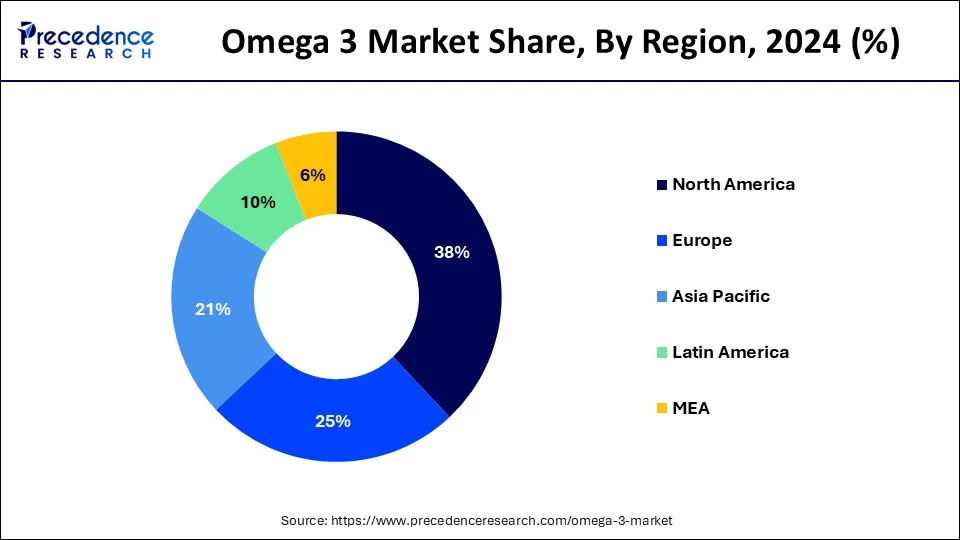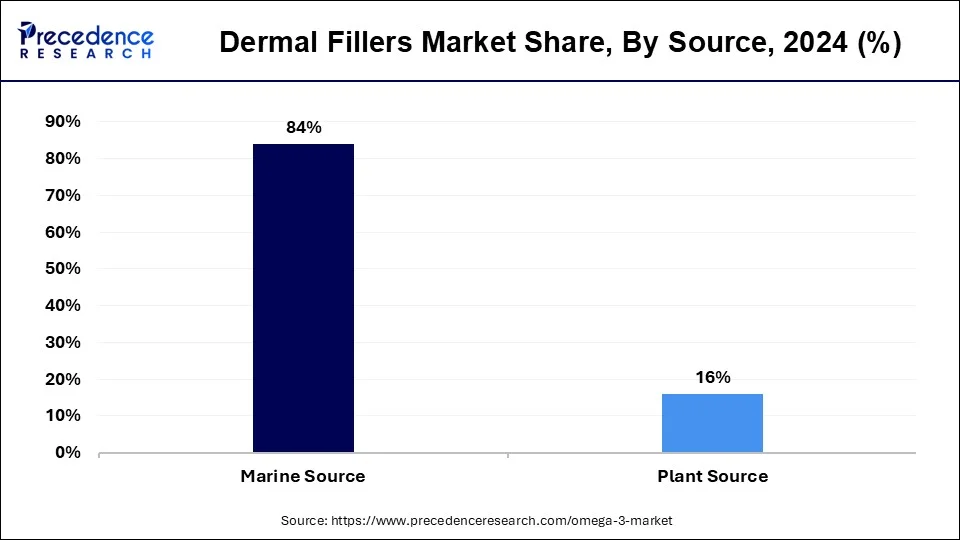The global omega 3 market size is estimated at USD 9.32 billion in 2025 and is predicted to reach around USD 17.86 billion by 2034, accelerating at a CAGR of 7.49% from 2025 to 2034. The North America omega 3 market size surpassed USD 3.29 billion in 2024 and is expanding at a CAGR of 7.51% during the forecast period. The market sizing and forecasts are revenue-based (USD Million/Billion), with 2024 as the base year.
The global omega 3 market size was estimated at USD 8.67 billion in 2024 and is predicted to increase from USD 9.32 billion in 2025 to approximately USD 17.86 billion by 2034, expanding at a CAGR of 7.49% from 2025 to 2034.

The U.S. omega 3 market size was estimated at USD 2.32 billion in 2024 and is predicted to be worth around USD 4.86 billion by 2034, at a CAGR of 7.68% from 2025 to 2034.

In the North American market, omega-3 fatty acids have become essential nutrients providing numerous health advantages, important for general wellness and lowering the chances of chronic illnesses. Predominantly sourced from certain fish, nuts, seeds, and plant oils, the inclusion of omega-3 in diets has been associated with numerous benefits, such as better cardiovascular health, reduced inflammation, and enhanced brain function.
The Omega-3 market is changing quickly, fueled by consumer knowledge, technological progress, and the need for sustainable options. Ongoing exploration of alternative sources and creative product formats positions the market for significant expansion. As ethical and health-aware buying behaviors affect consumer choices, Omega-3 continues to be an essential element of a balanced and proactive wellness strategy.

Asia Pacific's omega-3 market is anticipated to grow quickly throughout the course of the forecast timeframe. Consumer choice changes toward nutritious eating, beverage, and nutritional supplements are fueling income expansion in the Asia Pacific market. Additionally, the rising costs of hospitalization and unpleasant treatments have prompted customers to choose precautionary measures over curative ones, which means choosing healthy beverages and foods. This has led to a significant increase in demand for meals made with nutritional ingredients. Significant factors influencing the market's income expansion in this region include the abundance of materials available, the region's countries' affordable labor, and the existence of big corporations that employ omega-3 as a necessary element in a variety of goods.
Additionally, governments from different nations in this area are funding R&D projects to help women's nutritional status, which can aid in the fight against diseases like obesity and other cardiovascular conditions. To match the ongoing customer demand, numerous start-ups and new companies are expanding into this market sector with a variety of unique and improved products, including RuVega. This is helping the industry in this area grow in terms of revenue.
Japan Omega 3 Market Trends
The omega-3 market in Japan is expected to witness the highest compound annual growth rate. This can be credited to elements like the growing emphasis of various brands on incorporating omega-3 items into their offerings and a significant change in consumer tastes influenced by a tendency to favor dietary supplements and related products. The rising accessibility of worldwide brand products, the expanding incorporation of omega-3 in animal feed and medicines, and improved availability are anticipated to propel market growth during the forecast period. The Japanese fascination with omega 3 fatty acids, especially those derived from fish and fish oils, remains exceptionally robust. Generally, the Japanese typically obtain their dietary omega-3s from eating fish and shellfish daily, which is different from many consumers in the U.S. A portion of the motivation arises from the continuous flow of favorable epidemiological and clinical evidence both in Japan and elsewhere, validating the health advantages of particular long-chain omega-3s.
The omega-3 market is anticipated to be driven by rising consumer awareness of the benefits of polyunsaturated fatty acids for healthy eating and body composition, as well as rising investments in clinical research and development facilities. Additionally, rising chronic illness awareness and expanding product usage among active pharmaceutical ingredients (API) are anticipated to boost the market over the next several years.
The Omega-3 fatty acids help lower the risk of cardiopathy and support healthy skin. These are consumed along with a healthy lifestyle and regular physical activity to help reduce levels of certain blood fat (triglycerides) and raise levels of "good" cholesterol (HDL). Additionally, it's also desired to help with an immune disorder or high blood pressure. Chronic conditions are on the rise, and this ever-changing environment has helped the omega-3 market grow.
Consumers' growing knowledge of the importance of a balanced diet and the health advantages of omega-3 fatty acids, together with rising investments in clinical study and development, is anticipated to propel the global omega-3 market over the coming years. Omega-3 fatty acids are found in plants, nut oils, fish like salmon, tuna, and halibut, and other sea foods like krill and algae. These saturated fats are crucial for human development and growth in addition to brain function. Consuming omega-3 fatty acids reduces the risk of developing chronic illnesses like cancer, cardiovascular disease, or arthritis.
As health products gain popularity, top fish oil companies are focusing on delivering omega flax seed oil probiotics on the global market. Because of the intense rivalry, producers are adding more nutrients to their products. Leading fish oil companies are focusing on implementing new products into the global market due to the increased demand for oily fish from the pharmaceutical industry. Industries including fisheries, improved animal & pet food, supplementation & food ingredient, pharmaceuticals, and others all need large quantities of omega-3 fatty acids. Additionally, fish oil enhances cardiac health and helps the neurological system work properly.
Due to a greater understanding of the value of omega-3 fatty acids among both medical experts and the general public, fish oil demand has greatly increased. As a result, companies are expanding their lines of nutraceutical products that include boosted EPA and DHA. The growing need for DHA and EPA in human diets has had an influence on the market for oily fish worldwide.
| Report Coverage | Details |
| Market Size in 2024 | USD 8.67 Billion |
| Market Size in 2025 | USD 9.32 Billion |
| Market Size by 2034 | USD 17.86 Billion |
| Growth Rate from 2025 to 2034 | CAGR of 7.49% |
| Base Year | 2024 |
| Forecast Period | 2025 to 2034 |
| Segments Covered | By Type, By Source, and By End-Use |
| Regions Covered | North America, Europe, Asia-Pacific, Latin America, and Middle East & Africa |
Growing health knowledge of omega-3 fatty acid consumption
Marketing tactics and product endorsements to spur market expansion
Extremely volatile fish oil prices
Fish oil allergies and difficult extraction methods
The use of omega-3 fatty acids for animal feeds and medications is growing
Because DHA can help lower the risks associated with cardiac illnesses, the segment is anticipated to experience strong revenue growth during the projected period. DHA also aids in lowering blood triglycerides while raising HDL cholesterol levels and blood flow while doing mental work. Attention Deficit/hyperactivity/ Hyperactivity Disorder may be helped by DHA (ADHD).
Omega-3 fatty acids can be used to address impulsive behaviors and concentration problems experienced by people with ADHD. DHA possesses anti-inflammatory qualities that could lower the risk of time of life illnesses including gingivitis (periodontitis) as well as other heart-related disorders, as well as ameliorate autoimmune ailments like rheumatoid arthritis.
The marine category had the greatest share of the revenue in 2024 and also is anticipated to raise its revenue quickly over the next few years. The ocean resource of omega-3 acids is fish or fish oil. Fish high in omega-3 fatty acids include tuna, mackerel, sardines, herring, and salmon. Because they include critical nutrients like DHA and EPA fish oil or vitamins are crucial for preventing heart disorders. Additionally, it lessens the likelihood of an irregular heartbeat and decreases the growth of arterial plaque. Omega-3 concentration powder made from organic fish oils and distributed by AlaskOmega was introduced on January 4, 2020. This product doesn't taste or feel fishy and provides 205 mg/g of DHA and also EPA.

During the anticipated period, several new introductions are anticipated to fuel market expansion. During the projected timeframe, the nuts & seed sector is expected to experience substantial revenue growth. ALA is found in seeds like flaxseeds, which is crucial for human wellness and has been linked to several advantages like less inflammation, enhanced cardiovascular health, and preservation of the brain against the signs of aging. Additionally, research conducted in test tubes has generated comparable results, with multiple studies demonstrating that flaxseed oil can slow the growth of breast carcinoma cells.
Due to changing food requirements among customers, particularly younger generations around the world, the nutraceutical & supplement sector, which accounted for the biggest revenue share in 2024, is anticipated to increase rapidly over the forecast period. Additionally, as a result of the COVID-19 outbreak and the growing need for omega-3 nutritional supplements, companies are investing in modern production technology to produce cutting-edge goods on a wider scale and satisfy continuous demand.
During the predicted period, the infant formulae segment experienced consistent growth. It is advised to add omega-3 fatty acids to infant formulae because they contain docosahexaenoic acid (DHA) as well as arachidonic acid (ARA), which are present in breast milk. These healthy fatty acids support a child's neurological and visual development.
By Type
By Source
By End-Use
By Geography
For inquiries regarding discounts, bulk purchases, or customization requests, please contact us at sales@precedenceresearch.com
No cookie-cutter, only authentic analysis – take the 1st step to become a Precedence Research client